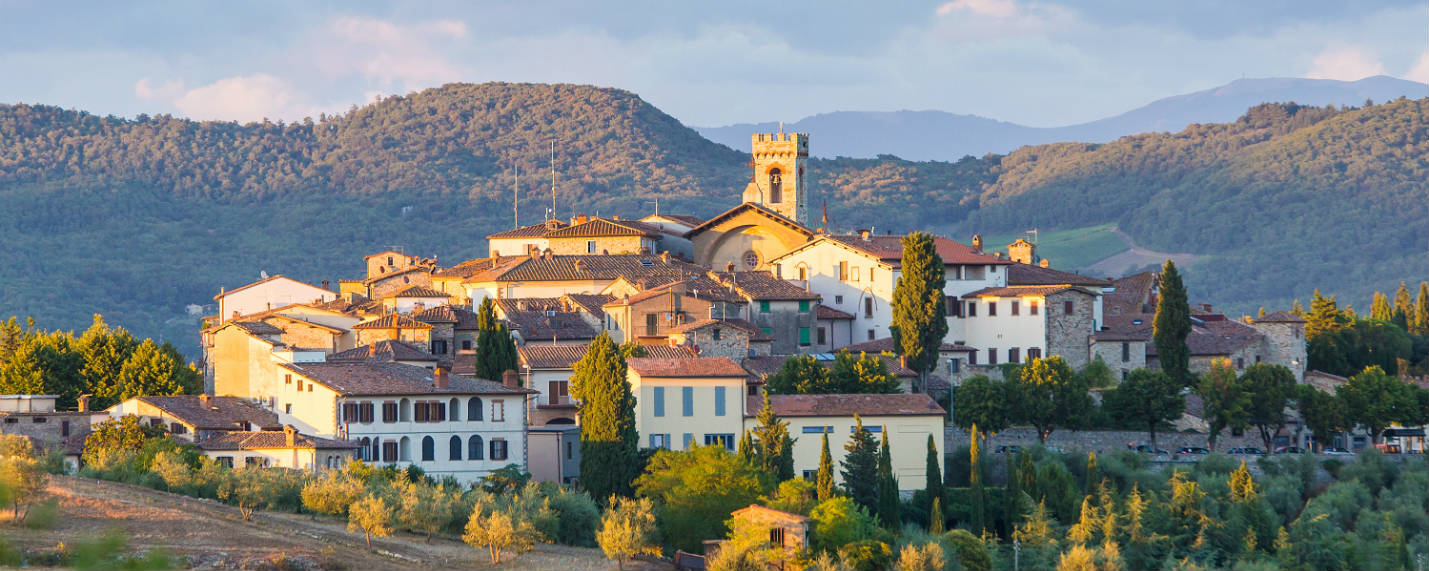Radda in Chianti
- Suitable for disabled people
- Orange Flag Countries
- City of wine
- Oil city
About the village
Radda in Chianti, a spectacular medieval village, was once the capital of the Chianti region. Enveloped by mighty walls, the village is located on the top of a hill that divides the valleys of Arbia and Pesa.
The area around the village has ancient origins, as shown by the archaeological area of Poggio la Croce where the remains of an ancient village emerged.
By the fall of the Roman Empire, in the fifth century, small agglomerations of rural character had already formed in the area which still exist today; these countries were Castelvecchi, Monterinaldi, Volpaia and the same Radda.
Between the 9th and 10th centuries the area of Radda saw the birth of the feudal society that involved the fortification of the villages.
The archaeological area of Poggio la Croce is located near the road that leads from Castellina in Chianti to Radda in Chianti.
It is placed on the top of the aforementioned hill. In this area a multi-layered archaeological site was discovered in which the oldest human presence in the Chianti area was identified.
The area has been inhabited since the Copper Age. In addition to that period, evidence of a shepherd village dating back to the end of the Bronze Age emerged. In addition to the previous ones, the area appears to have been inhabited also in the Protovillanovian period (XI century BC), of which the remains of two buildings have emerged but also the foundations of a gateway to the village, a fortification and some remains of a wine press.
Village of Radda in Chianti
The Municipality of Radda in Chianti
Province of Siena
Tuscany Region
inhabitants: 1.577 raddesi
Altitude center: 530 m a.s.l.
The Municipality is part of:
Città del vino
Acknowledgments
Orange Flag - Italian Touring Club
Municipality
Piazza F. Ferrucci 1 - Tel. +39 0577 783791
16.24 Kilometers from Radda in Chianti
79.53 Kilometers from Radda in Chianti
48.79 Kilometers from Radda in Chianti
68.28 Kilometers from Radda in Chianti
38.66 Kilometers from Radda in Chianti
70.04 Kilometers from Radda in Chianti
BY CAR
- From the North: Take the A1 highway towards Rome. Exit at Firenze Certosa and merge onto the Firenze-Siena highway, exit at San Donato in Poggio and continue towards Castellina in Chianti, upon reaching Castellina in Chianti follow the indications for Radda in Chianti, take the SS 429 to Radda in Chianti;
- or, exit at Firenze Sud, take the SR 222 Chiantigiana and follow the indications for Radda in Chianti.
- From the South: Take the A1 motorway towards Florence, exit at Montevarchi-Valdarno, in Montevarchi follow the signs for Gaiole in Chianti, take the SS 408 and then turn towards Radda in Chianti taking the SS 429.
ON THE TRAIN
- Montevarchi railway station
- Chiusi railway station
BY PLANE
- Florence airport
- Pisa airport
Sitting at a table on the outdoor terrace of some farm or farmhouse, we contemplate at the sunset light the enchanting panorama of the Chianti territory. On the table a bottle just uncorked of that full-bodied red juice that takes its name from the hills where it is born.
Radda, located in the heart of this territory, is part of a landscape shaped by the slow action of the hand of the man, the result of the dynamic relationship between nature and culture and for that this becomes the dwelling of a community and its history.
The village, historically extreme defensive bulwark of the boundaries of Florence towards the Sienese territory, has not experienced changes in the urban system in the course of the centuries, maintaining the beautiful elliptic plant, marked by the walls and by the traces of two ancient access ports. It offers itself the visitor letting him pass quickly along the winding main street but leaves us the possibility of a journey more meditated in the network of alleys, which lead to the discovery of the most hidden corners.
Of absolute importance, just outside the village you can find the former convent of Santa Maria al Prato, today house of the Foundation for the Protection of the Territory of the Chianti Classico, with the Church of origin fourteenth century which houses a beautiful wooden altarpiece late fifteenth century, the work of the painter Neri di Bicci, depicting the Virgin on the throne with the Child, flanked by the Saints Nicholas, Giovanni Battista, Maddalena and Antonio Abate.
Discover the other villages on the guide Tuscany - Unique Villages to Love
Sleep, eat, buy...
80.55 Kilometers from Radda in Chianti
80.05 Kilometers from Radda in Chianti
40.66 Kilometers from Radda in Chianti
51.50 Kilometers from Radda in Chianti
79.73 Kilometers from Radda in Chianti
78.06 Kilometers from Radda in Chianti
79.61 Kilometers from Radda in Chianti
28.54 Kilometers from Radda in Chianti
80.74 Kilometers from Radda in Chianti
80.43 Kilometers from Radda in Chianti
25.89 Kilometers from Radda in Chianti
80.74 Kilometers from Radda in Chianti










